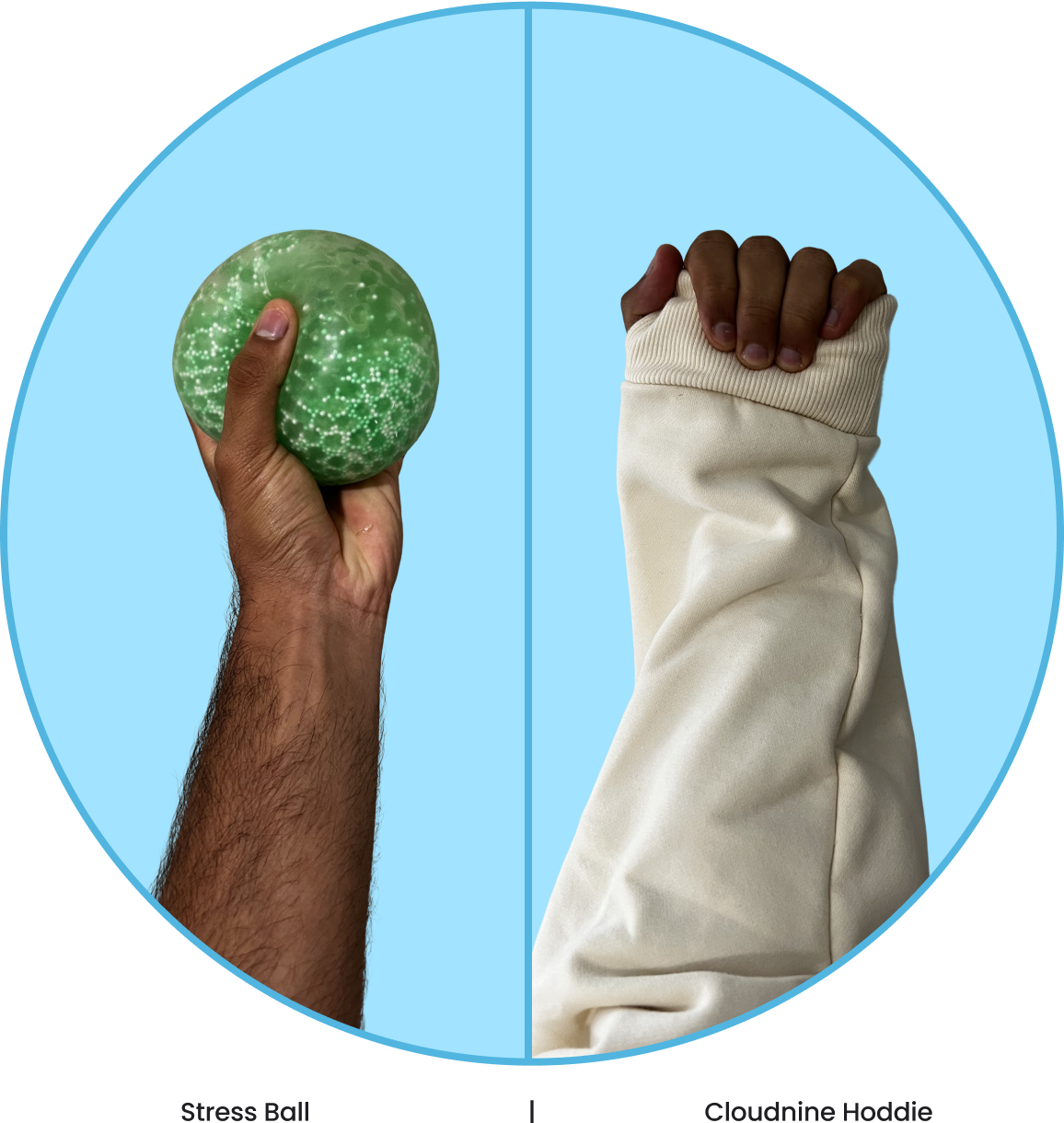Trusted by Mental Health Experts
Dallas Fortin
Mental Health Therapist“This is not a hoodie, it is a self regulation tool disguised as a hoodie”
Annalisa Barrett
Licensed Therapist“Cloud has invented this sweatshirt that gives us a more adaptive way of externalizing that fidgety energy.”
sherilin
ABA Therapist“The hoodie looks like everyone else’s meaning the child is not being singled out which means a-lot ”
Melissa
Licensed TherapistAs a therapist I am really impressed. It’s really well made, and its also got a very unique calming effect
the power of stress balls
6 in 10
people using stress balls had lower anxiety levels than those who did not.1
 What does that mean?
What does that mean?
Squeezing, rolling, or tossing a stress ball forms of simple, repetitive physical movement can significantly reduce anxiety levels.
 What does that mean?
What does that mean?
Squeezing, rolling, or tossing a stress ball forms of simple, repetitive physical movement can significantly reduce anxiety levels.
How it helps
Anxiety
Stress balls have been proven in clinical trials to help reduce anxiety, as it gives the hands something to focus on. This helps calm the mind and body. One study including Hemodialysis patients using stress balls experienced a statistically significant decrease in anxiety level [1]. Another study on Angiography patients also reported lower stress and pain levels when using them [2]. The repeated squeezing helps release muscle tension and shift focus away from anxious thoughts, making stress balls a medically supported tool for managing anxiety [3].
ADHD
Backed by research as it has been tested, and shown to reduce emotional reactivity by disrupting the link between fidgeting and physiological stress responses [1]. In classroom settings, students who used stress balls demonstrated improved focus, writing performance, and peer interaction, especially among those with attention challenges [2]. One pilot study even noted enhanced engagement and reduced off-task behavior when stress balls were introduced during lessons [3]. These results suggest stress balls provide both sensory regulation and cognitive support for individuals with ADHD.
Autism
Stress balls offer sensory input that helps regulate the nervous system in individuals with autism, aiding in calming responses during overstimulation or transitions [1]. Studies in occupational and behavioral therapy report that stress balls can promote focus and reduce anxiety through proprioceptive feedback and repetitive motion [2]. In educational settings, they support self-regulation, improve task engagement, and offer a non-verbal outlet for managing emotions [3]. Given their simplicity, portability, and proven sensory benefits, stress balls are a valuable tool in supporting the daily emotional and cognitive needs of individuals with autism.
General
Clinically proven to reduce stress, anxiety, and physiological tension in a wide range of people, from patients undergoing surgery to everyday users like students, parents, and office workers [1]. Their calming effect works through rhythmic tactile input, helping the brain refocus and regulate emotions during high-pressure moments [2]. The same sensory action makes stress balls an effective habit-replacement tool for nail biting, with studies showing significant nail growth and reduced compulsive behavior through Object Manipulation Training [3]. Backed by clinical trials and expert recommendations, stress balls offer a simple, low-cost solution that’s universally applicable for managing stress and breaking unhealthy habits.
Deep pressure input
Why Touch Works
It triggers responses such as reduced heart rate, lower blood pressure, and increased oxytocin.3
 What does that mean?
What does that mean?
Touch works to reduce anxiety because it triggers physiological and emotional responses that calm the body and mind.
Anxiety Spike
Rapid heartbeat, shallow breathing, racing thoughts.
Gentle Touch Applied
Activities such as hugging, a tactile device, etc.
Activation of CT Afferent Nerves
Specialized touch receptors send calming signals to the brain.
Neurochemical Response
Release of oxytocin, serotonin, dopamine; reduction of cortisol
Physiological Shifts
Heart rate and blood pressure decrease, breathing slows.
Emotional Regulation
Sense of safety, comfort, and connection increases.
State of Calm
Anxiety symptoms diminish; body and mind relax
 What does that mean?
What does that mean?
Touch works to reduce anxiety because it triggers physiological and emotional responses that calm the body and mind.
Stress Ball vs Cloudnine
We’ve adopted the stress ball into everyday clothing so you can be stress-free in any situation.

Stress Ball
Cloudnine

Can be noticable to others

Discreet, built-in

Easy to lose or forget

Always with you as part of your outfit

Only works for your hands

Combine tactile therapy with cozy clothing

Must be carried separately

Integrated to your hoddie

No style element

Fashion-forward, stylish hoddie
how cozy clothing helps
Not just style
it’s a choice that gives a significant changes on our mood, confidence, and behaviour.4
 What does that mean?
What does that mean?
Clothing plays a powerful role in shaping psychological well-being and social dynamics. Choose clothing that fits our needs both mentally and physically.
Feel Safe


Relaxation

Comfort

Stress Reduction


Boost Mood


Calmness
 What does that mean?
What does that mean?
Clothing plays a powerful role in shaping psychological well-being and social dynamics. Choose clothing that fits our needs both mentally and physically.
Emotional Highs
of those who engaged in stimming, were most likely to do so when they felt high-arousal emotions such as anxiety.5
 What does that mean?
What does that mean?
For many, especially those with anxiety, ADHD, or autism, stimming is a natural way to self-regulate and find calm in overwhelming situations.
Anxiety Spike
Rapid heartbeat, shallow breathing, racing thoughts.
Gentle Touch Applied
Activities such as hugging, a tactile device, etc.
Activation of CT Afferent Nerves
Specialized touch receptors send calming signals to the brain.
Neurochemical Response
Release of oxytocin, serotonin, dopamine; reduction of cortisol
Physiological Shifts
Heart rate and blood pressure decrease, breathing slows.
Emotional Regulation
Sense of safety, comfort, and connection increases.
State of Calm
Anxiety symptoms diminish; body and mind relax
 What does that mean?
What does that mean?
For many, especially those with anxiety, ADHD, or autism, stimming is a natural way to self-regulate and find calm in overwhelming situations.
Emotional Highs
of those who engaged in stimming, were most likely to do so when they felt high-arousal emotions such as anxiety.5
 What does that mean?
What does that mean?
For many, especially those with anxiety, ADHD, or autism, stimming is a natural way to self-regulate and find calm in overwhelming situations.
We’re giving a full support
Designed with a built-in stress ball discreetly sewn into the sleeve. This feature is intentionally created to support stimming behaviors in a socially acceptable, accessible way.

Tactile Stimulation
Squeezing the stress ball calms and regulates sensory needs.

On-the-Go Relief
Instant calming tool, always available in your hoodie.

Discreet Fidgeting
Built-in stress ball lets you stim privately, even in public.

Comfort and Security
Soft, weighted fabric adds a sense of safety and grounding.
References
Anxiety
- A statistically significant decrease in anxiety levels (Visual Analog Scale) with a very large effect size (d = 1.69).
- The group using stress balls had significantly lower anxiety (STAI) and pain levels (NRS) post-procedure compared to the control group (p < 0.05).
- Progressive muscle relaxation: The squeeze release cycle calms muscle tension and can lower heart rate, similar to formal relaxation techniques.
ADHD
- Physiological evidence: stress balls can alter stress responses in adults with ADHD
A controlled trial with adults who have ADHD used a fidget (stress) ball during stressful tests.
It didn’t change the average heart rate or HRV, but it did break the usual link between fidgeting and decreased physiological self-regulation.
In other words, using the ball helped uncouple nervous fidgeting from stress markers, suggesting it helped moderate the body’s stress response and emotional reactivity. - Health Central also reports that in a small study of sixth-graders, using stress balls during lessons reduced distractions and supported attention spans, especially for kinesthetic learners.
- A 2006 pilot study found that sixth-graders using stress balls during class showed better attitude, attention, writing performance, and peer interactions
Autism
- Stress balls provide tactile and proprioceptive input, which helps calm individuals with sensory processing challenges common in autism.
- Stress balls provide tactile and proprioceptive input, which helps calm individuals with sensory processing challenges common in autism.
- Stress balls offer a non‑verbal outlet for emotions, helping reduce meltdowns and improve self-regulation, particularly in situations of frustration or overstimulation.
General
- A cross-over RCT with 65 hemodialysis patients found that daily use of stress balls for 4 weeks significantly reduced anxiety and depression compared to control periods and the benefits persisted a month later.
Another RCT with 45 dialysis patients reported that while vital signs remained unchanged, those squeezing stress balls during sessions had significantly lower perceived stress than controls.
- Distraction & tactile engagement: Squeezing helps shift attention away from stress, mirroring mindfulness techniques.
- A randomized controlled trial with children and adolescents compared Habit Reversal Training (HRT) and Object Manipulation Training (OMT), which includes using stress balls. Both were more effective than no treatment. After 3 months:
Both interventions significantly increased nail length, with HRT being slightly more effective, but OMT still offering strong long-term benefits.
- The Effectiveness Of Stress Ball Therapy To Reduce Anxiety Level In Covid 19 Patients In Pati Central Java
- Effectiveness Of Stress Ball And Relaxation Exercises On Polymerase Chain Reaction Rrt Pcr Test Induced Fear And Pain In Adolescents In Türkiye
- A Calming Hug Design And Validation Of A Tactile Aid To Ease Anxiety
- Investigating The Psychological Effects Of Clothing Choices On Wearer S Mood Confidence And Behaviour
- Beyond Self Regulation Autistic Experiences And Perceptions Of Stimming














